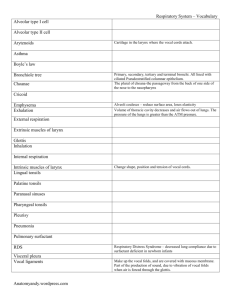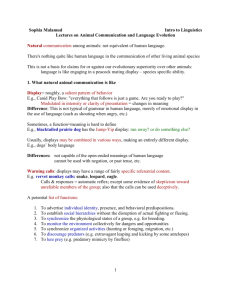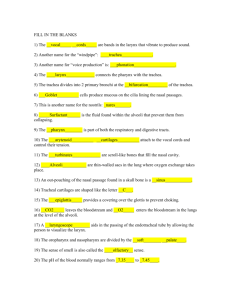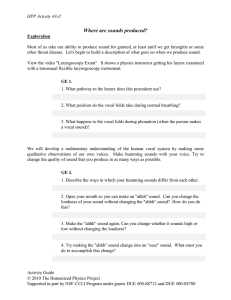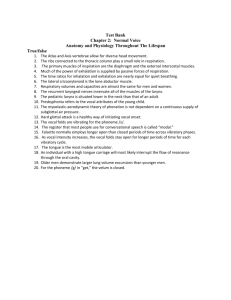Raised versus lowered larynx singing
advertisement
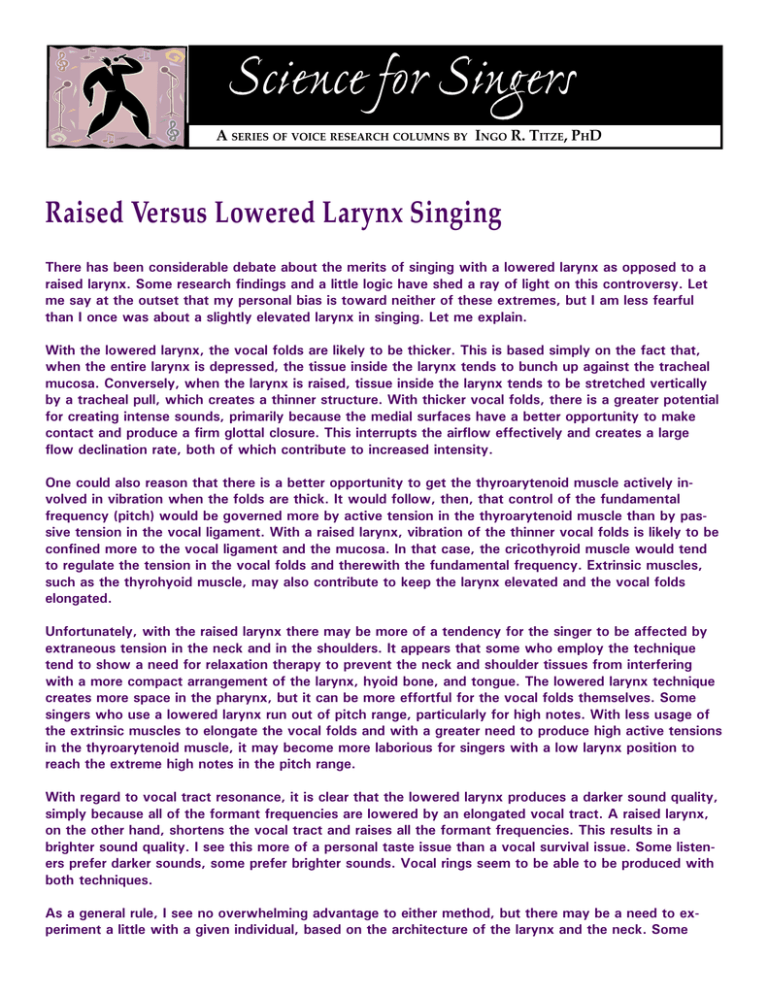
Science for Singers A SERIES OF VOICE RESEARCH COLUMNS BY INGO R. TITZE, PHD Raised Versus Lowered Larynx Singing There has been considerable debate about the merits of singing with a lowered larynx as opposed to a raised larynx. Some research findings and a little logic have shed a ray of light on this controversy. Let me say at the outset that my personal bias is toward neither of these extremes, but I am less fearful than I once was about a slightly elevated larynx in singing. Let me explain. With the lowered larynx, the vocal folds are likely to be thicker. This is based simply on the fact that, when the entire larynx is depressed, the tissue inside the larynx tends to bunch up against the tracheal mucosa. Conversely, when the larynx is raised, tissue inside the larynx tends to be stretched vertically by a tracheal pull, which creates a thinner structure. With thicker vocal folds, there is a greater potential for creating intense sounds, primarily because the medial surfaces have a better opportunity to make contact and produce a firm glottal closure. This interrupts the airflow effectively and creates a large flow declination rate, both of which contribute to increased intensity. One could also reason that there is a better opportunity to get the thyroarytenoid muscle actively involved in vibration when the folds are thick. It would follow, then, that control of the fundamental frequency (pitch) would be governed more by active tension in the thyroarytenoid muscle than by passive tension in the vocal ligament. With a raised larynx, vibration of the thinner vocal folds is likely to be confined more to the vocal ligament and the mucosa. In that case, the cricothyroid muscle would tend to regulate the tension in the vocal folds and therewith the fundamental frequency. Extrinsic muscles, such as the thyrohyoid muscle, may also contribute to keep the larynx elevated and the vocal folds elongated. Unfortunately, with the raised larynx there may be more of a tendency for the singer to be affected by extraneous tension in the neck and in the shoulders. It appears that some who employ the technique tend to show a need for relaxation therapy to prevent the neck and shoulder tissues from interfering with a more compact arrangement of the larynx, hyoid bone, and tongue. The lowered larynx technique creates more space in the pharynx, but it can be more effortful for the vocal folds themselves. Some singers who use a lowered larynx run out of pitch range, particularly for high notes. With less usage of the extrinsic muscles to elongate the vocal folds and with a greater need to produce high active tensions in the thyroarytenoid muscle, it may become more laborious for singers with a low larynx position to reach the extreme high notes in the pitch range. With regard to vocal tract resonance, it is clear that the lowered larynx produces a darker sound quality, simply because all of the formant frequencies are lowered by an elongated vocal tract. A raised larynx, on the other hand, shortens the vocal tract and raises all the formant frequencies. This results in a brighter sound quality. I see this more of a personal taste issue than a vocal survival issue. Some listeners prefer darker sounds, some prefer brighter sounds. Vocal rings seem to be able to be produced with both techniques. As a general rule, I see no overwhelming advantage to either method, but there may be a need to experiment a little with a given individual, based on the architecture of the larynx and the neck. Some singers who have never been able to produce certain notes may be able to do so quickly by allowing the larynx to move one way or the other, and singers who have never been able to increase their vocal power may suddenly experience new freedom with a less prescribed approach. Given no strong advantages in either direction, it would seem best to start with a neutral position, where the larynx does not travel much in either direction during voice onset. Then, if there are persistent shortcomings, it may be useful to explore a little, allowing both student and singer to adjust to the new sound qualities and hopefully more flexibility in the voice. This column originally appeared in the November/December 1993 issue of The NATS Journal.
